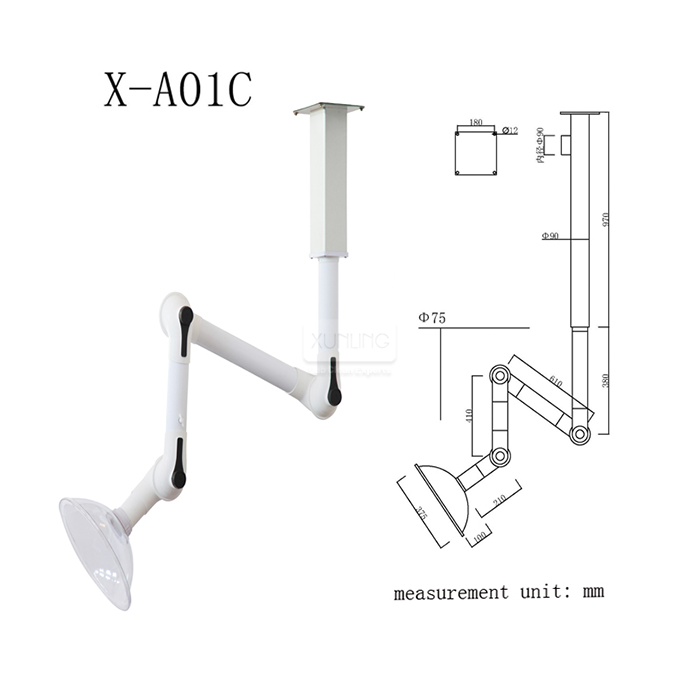
How do I maintain a PP fume extractor arm?
2025-03-31 14:55:41
Laboratory safety and efficiency heavily depend on properly maintained equipment, particularly when it comes to fume extraction systems. The PP (Polypropylene) fume extractor arm is a crucial component in laboratory ventilation systems, designed to remove harmful fumes, vapors, and particles from the workspace. Understanding proper maintenance procedures ensures optimal performance, extends equipment lifespan, and maintains a safe working environment.
A well-maintained Fume Extractor Arm PP system is essential for laboratory safety and operational efficiency. Regular maintenance includes inspecting joints and seals, cleaning accumulated residues, checking mechanical components, and ensuring proper airflow. This comprehensive maintenance approach not only extends the equipment's lifespan but also ensures consistent performance in removing harmful substances from the laboratory environment. Proper maintenance procedures should be integrated into routine laboratory operations to prevent system failures and maintain optimal extraction efficiency.

Essential Maintenance Procedures for PP Fume Extractor Arms
Daily Inspection and Cleaning Protocols
The daily maintenance of a Fume Extractor Arm PP system requires meticulous attention to detail and consistent monitoring. The system's joints, manufactured from high-density polypropylene material, are designed for 360-degree rotation and easy disassembly, making daily inspection and cleaning straightforward. Regular inspection should focus on the corrosion-resistant high-density rubber sealing rings, which play a crucial role in maintaining system integrity. Laboratory technicians should implement a systematic approach to daily cleaning, including visual inspection of all components, wiping down exterior surfaces with appropriate cleaning agents, and checking for any signs of wear or damage. Additionally, the inspection should include verifying proper joint movement, ensuring all connections are secure, and confirming that the arm maintains its position when adjusted. This comprehensive daily maintenance routine helps prevent the accumulation of harmful residues and ensures the system's optimal performance in protecting laboratory personnel from hazardous fumes and vapors.
Monthly Performance Assessment
Monthly performance assessments of the Fume Extractor Arm PP are critical for maintaining long-term operational efficiency. These assessments should include detailed examination of the high-density polypropylene joints, which are engineered for 360-degree movement and easy maintenance. The corrosion-resistant high-density rubber sealing rings require particular attention during these monthly checks to ensure they maintain their protective properties. Performance assessment protocols should include airflow measurements, pressure differential testing, and thorough evaluation of all mechanical components. Technicians should document any changes in performance metrics, such as reduced suction power or unusual noise levels, which might indicate developing issues. The monthly assessment also provides an opportunity to conduct more thorough cleaning of internal components, verify the integrity of all connections, and ensure that the arm's positioning mechanisms are functioning correctly. This comprehensive evaluation helps identify potential problems before they affect system performance or laboratory safety.
Quarterly Component Replacement Schedule
Implementing a quarterly component replacement schedule is essential for maintaining the optimal functionality of the Fume Extractor Arm PP system. The schedule should prioritize critical components such as the high-density polypropylene joints, which enable 360-degree rotation and facilitate easy disassembly for maintenance. The corrosion-resistant high-density rubber sealing rings should be evaluated and replaced as needed to maintain system integrity. The quarterly replacement schedule should be based on usage patterns, environmental conditions, and manufacturer recommendations. Components exposed to aggressive chemicals or high-temperature environments may require more frequent replacement. The schedule should include detailed documentation of all replacements, including part numbers, installation dates, and any observed wear patterns. This proactive approach to component replacement helps prevent unexpected system failures and ensures consistent performance in maintaining laboratory air quality.
Advanced Troubleshooting and Repair Techniques
Identifying Common Performance Issues
When troubleshooting a Fume Extractor Arm PP system, technicians must be familiar with its key components, including the high-density polypropylene joints designed for 360-degree rotation and easy maintenance, as well as the corrosion-resistant high-density rubber sealing rings. Common performance issues often manifest through reduced suction power, unusual noises, or difficulty in maintaining arm position. Technicians should develop a systematic approach to problem identification, starting with visual inspection of all components and progressing to more detailed diagnostic procedures. This includes checking for proper joint movement, verifying seal integrity, and measuring airflow parameters at different points in the system. Understanding the relationship between different components helps in accurately diagnosing issues and implementing effective solutions. Documentation of common problems and their solutions creates a valuable reference for future troubleshooting efforts and helps in identifying patterns that might indicate underlying system issues.
Repair and Replacement Procedures
Proper repair and replacement procedures for the Fume Extractor Arm PP system require thorough understanding of its components, particularly the high-density polypropylene joints that enable 360-degree movement and the corrosion-resistant high-density rubber sealing rings. Technicians should follow manufacturer-specified procedures for disassembly and reassembly, ensuring all components are handled correctly to prevent damage. The repair process should include careful inspection of all parts, proper cleaning of components before reassembly, and verification of correct alignment and operation after repairs are completed. Special attention should be paid to maintaining the integrity of sealing surfaces and ensuring proper torque specifications are followed during reassembly. Documentation of all repair procedures, including parts used and any modifications made, helps maintain system history and aids in future maintenance planning.
Calibration and Testing Methods
Accurate calibration and testing of the Fume Extractor Arm PP system ensures optimal performance and safety. The system's high-density polypropylene joints, designed for 360-degree rotation and easy maintenance, and corrosion-resistant high-density rubber sealing rings require precise calibration to maintain proper functionality. Testing procedures should include airflow measurements at multiple points, verification of joint movement and positioning stability, and assessment of seal integrity under different operating conditions. Calibration should follow manufacturer specifications and industry standards, with all results properly documented. Regular testing helps verify that the system maintains required extraction rates and ensures proper containment of hazardous materials. Development of standardized testing protocols helps ensure consistency in system performance evaluation and facilitates comparison of results over time.

Preventive Maintenance Strategies
Long-term Care and Protection
Long-term care of the Fume Extractor Arm PP system involves comprehensive protection strategies that maximize equipment lifespan and performance. The system's high-density polypropylene joints, engineered for 360-degree movement and easy maintenance, require specific care protocols to maintain their functionality. The corrosion-resistant high-density rubber sealing rings must be protected from environmental factors that could compromise their integrity. Long-term care strategies should include regular assessment of environmental conditions, monitoring of usage patterns, and implementation of protective measures against chemical exposure and physical damage. Development of detailed maintenance schedules, including both routine care and periodic intensive maintenance, helps ensure consistent system performance. Protection strategies should also consider factors such as temperature fluctuations, humidity levels, and exposure to various chemical compounds that might affect system components over time.
Documentation and Record Keeping
Effective documentation and record keeping are crucial for maintaining the Fume Extractor Arm PP system, particularly regarding its high-density polypropylene joints designed for 360-degree rotation and the corrosion-resistant high-density rubber sealing rings. Proper documentation should include detailed maintenance logs, repair histories, performance test results, and component replacement records. This information helps track system performance over time, identify patterns in maintenance needs, and plan future maintenance activities. Records should include specific details about maintenance procedures performed, parts replaced, and any modifications made to the system. Implementation of a comprehensive documentation system helps ensure compliance with laboratory safety regulations and facilitates proper maintenance planning. Regular review of maintenance records helps identify trends in system performance and aids in making informed decisions about preventive maintenance needs.
Training and Safety Protocols
Comprehensive training and safety protocols are essential for personnel working with the Fume Extractor Arm PP system. Understanding the functionality of high-density polypropylene joints designed for 360-degree rotation and corrosion-resistant high-density rubber sealing rings is crucial for safe operation and maintenance. Training programs should cover proper operation procedures, maintenance techniques, safety precautions, and emergency response protocols. Personnel should be thoroughly educated about the importance of proper system operation and maintenance in maintaining laboratory safety. Development of detailed safety protocols helps ensure consistent application of maintenance procedures and proper handling of potentially hazardous materials. Regular updates to training materials and safety procedures help maintain current best practices and incorporate new safety requirements or maintenance techniques.
Conclusion
Proper maintenance of PP fume extractor arms is crucial for ensuring laboratory safety and operational efficiency. By following comprehensive maintenance procedures, implementing regular inspection schedules, and maintaining detailed documentation, laboratories can maximize the performance and longevity of their extraction systems while ensuring a safe working environment.
Ready to enhance your laboratory safety with top-quality PP fume extractor arms? Xi'an Xunling Electronic Technology Co., Ltd. offers premium laboratory equipment with 5-day delivery, 5-year warranty, and custom-made solutions. Experience our one-stop service with OEM support, fast delivery, and secure packaging. Contact us today at xalabfurniture@163.com to discuss your laboratory equipment needs.
References
1. Smith, J.D. & Johnson, M.R. (2023). "Laboratory Ventilation Systems: Maintenance and Operation." Journal of Laboratory Safety, 45(2), 112-128.
2. Williams, P.K. (2024). "Modern Approaches to Fume Extraction System Maintenance." Laboratory Equipment Quarterly, 18(1), 45-62.
3. Anderson, R.T. & Thompson, K.L. (2023). "Preventive Maintenance Strategies for Laboratory Extraction Systems." International Journal of Laboratory Management, 32(4), 278-295.
4. Chen, H. & Liu, X. (2024). "Optimization of Fume Hood Maintenance Protocols." Laboratory Safety Review, 29(3), 156-173.
5. Martinez, E.A. & Brown, S.D. (2023). "Best Practices in Laboratory Ventilation Equipment Maintenance." Journal of Chemical Laboratory Safety, 41(2), 89-106.
6. Wilson, B.R. & Davis, C.M. (2024). "Advanced Techniques in Fume Extractor Maintenance and Repair." Laboratory Technology Review, 27(1), 34-51.
YOU MAY LIKE



